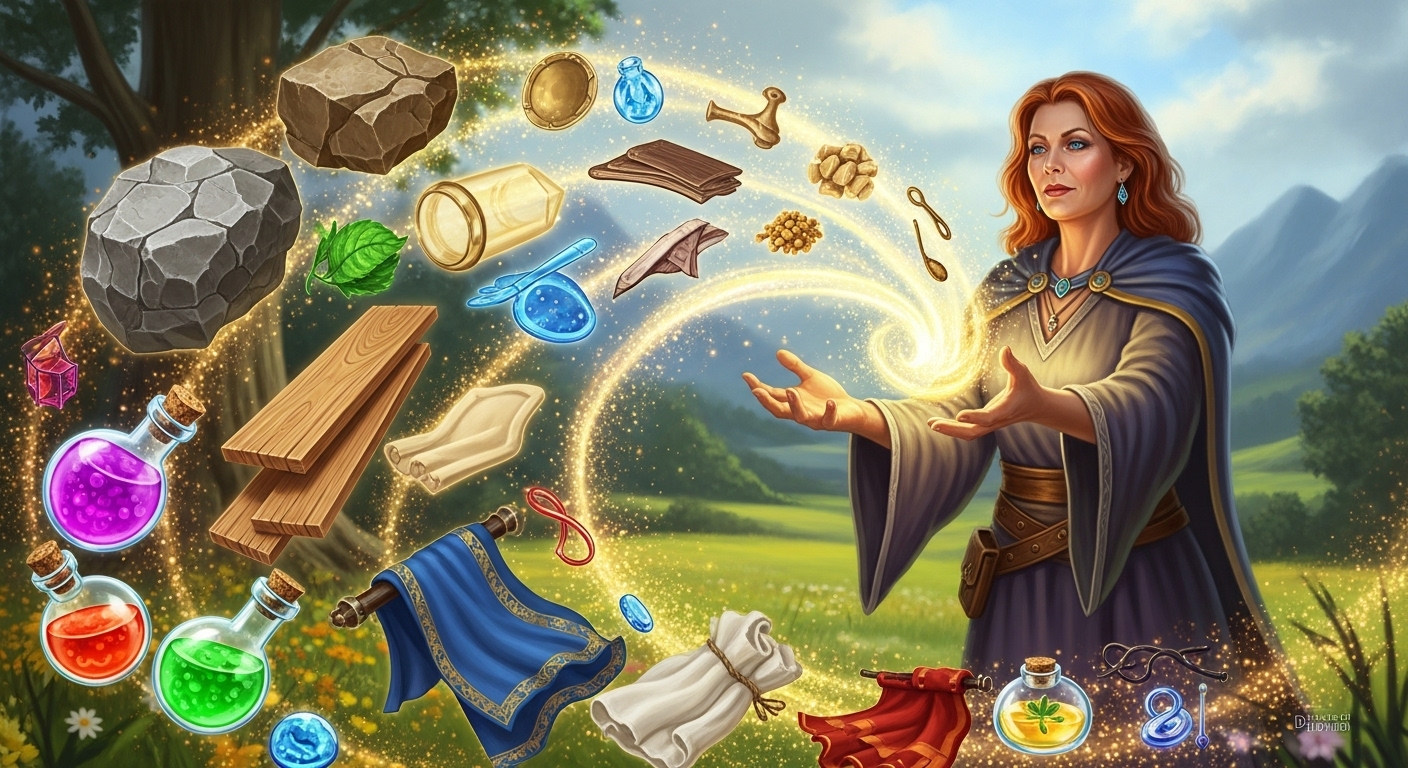Creation

- Level: 5
- School: Illusion
- Class: Sorcerer, Wizard
- Casting Time: 1 minute
- Range: 30 feet
- Components: V, S, M (a paintbrush)
- Duration: Special
You pull wisps of shadow material from the Shadowfell to create an object within range. It is either an object of vegetable matter (soft goods, rope, wood, and the like) or mineral matter (stone, crystal, metal, and the like). The object must be no larger than a 5-foot Cube, and the object must be of a form and material that you have seen.
The spell's duration depends on the object's material, as shown in the Materials table. If the object is composed of multiple materials, use the shortest duration. Using any object created by this spell as another spell's Material component causes the other spell to fail.
Materials
| Material | Duration |
|---|---|
| Vegetable matter | 24 hours |
| Stone or crystal | 12 hours |
| Precious metals | 1 hour |
| Gems | 10 minutes |
| Adamantine or mithral | 1 minute |
Using a Higher-Level Spell Slot. The Cube increases by 5 feet for each spell slot level above 5.
Tactical Usage
Temporary Object Creation: Creation provides versatile item generation for immediate tactical needs. This 5th-level illusion spell excels at creating tools, barriers, and equipment when standard resources are unavailable.
Optimal Timing: Most effective when you need specific items for obstacles, repairs, or tactical advantages that standard equipment cannot provide.
Resource Management: Uses a 5th-level spell slot - available from character level 9+. Duration varies significantly based on material complexity.
Target Selection: Choose materials based on needed duration - vegetable matter for long-term use, precious materials for short-term tactical advantages.
Spell Combinations
Synergistic Spells:
- Enhancement Magic: Combine with magic weapon or similar spells to enhance created items
- Utility Magic: Layer with other problem-solving spells for comprehensive solutions
- Duration Extension: Time-manipulation magic might extend object duration
Class Feature Interactions:
- Illusion School: Wizards gain enhanced illusion magic benefits
- Crafting Skills: Enhanced crafting abilities improve object design and utility
- Material Knowledge: Understanding of materials improves creation efficiency
Multi-Caster Coordination: Multiple casters can create complex multi-component items or structures.
Material Component Details
Component Acquisition: Paintbrush - simple tool available from artists, crafters, or general merchants.
Component Handling: Reusable component that doesn't consume during casting, making repeated use economical.
Roleplay Opportunities: Different brush types or artistic styles can reflect character background and magical traditions.
Economic Considerations: Minimal component cost makes this economically viable despite high spell slot requirement.
Creator Notes
Encounter Balancing: Can bypass obstacles, create tools, or provide equipment that dramatically alters encounter solutions.
NPC Usage: Wizards or sorcerers can create needed items on demand, providing flexible problem-solving for story needs.
Environmental Considerations: Created objects have limited durability based on material type, creating planning considerations.
Campaign Integration: Excellent for puzzle-solving, resource scarcity scenarios, or creative problem-solving situations.
Environmental Interactions
Terrain Effects: 30-foot range allows placement in various locations. Created objects interact normally with environment.
Weather Influence: Created objects affected by weather like natural materials of their type.
Structural Interactions: Can create structural components, tools, or equipment as needed for specific situations.
Elemental Interactions: Material type determines interactions - metal conducts electricity, wood burns, stone resists elements.
Common Rulings & Clarifications
Timing Questions: 1-minute casting time requires uninterrupted preparation. Duration varies by material type.
Target Limitations: Must be objects you've seen before. Cannot exceed 5-foot cube base size.
Duration Interactions: Shortest duration applies to multi-material objects. Cannot be used as spell components.
Mechanical Interactions: Upcast levels increase cube size by 5 feet per level above 5th.
Alternative Applications
Non-Combat Uses: Emergency repairs, crafting temporary tools, creating artistic objects, or providing missing equipment.
Social Encounters: Create gifts, demonstration objects, or items needed for social interactions.
Exploration Applications: Bridge materials, climbing equipment, containers, or specialized tools for environmental challenges.
Utility Functions: Temporary shelter components, crafting materials, art creation, or emergency replacement items.
Related Spells
Same School: Other illusion spells like major image (3rd level visual illusion), programmed illusion (6th level automated illusion), mirage arcane (7th level terrain illusion).
Similar Effects: fabricate (4th level permanent crafting), minor creation (if exists - temporary items), wish (9th level reality alteration).
Progression Options: prestidigitation (cantrip minor effects), creation (5th level temporary objects), wish (9th level permanent reality changes).
Complementary Magic: identify (understand created materials), mending (repair created items), fabricate (permanent object creation).
Scaling Analysis
Level Progression: Remains valuable throughout high-level play for creative problem-solving and resource generation.
Upcast Benefits: Larger cube sizes allow creation of more substantial objects and structures.
Campaign Phases: Peak effectiveness in mid-to-high level play (9+) where creative solutions become increasingly important.
Comparative Value: Excellent problem-solving magic that justifies 5th-level slot investment for unique situations.
Narrative Flavor
Casting Description: Shadow energy coalesces as your paintbrush traces patterns in the air, drawing forth semi-real matter from the Shadowfell.
Effect Manifestation: Wisps of shadow solidify into the desired object, gaining substance and texture that mirrors real materials.
Personal Style: Wizards might use precise geometric strokes, while sorcerers channel chaotic creative energy through instinctive artistic expression.
World Integration: Represents advanced illusion magic that bridges reality and shadow, often associated with planar magic, artistic creation, or emergency resourcefulness.